#omar 76
Text
Music Monday
Tagging @socially-awkward-skeleton @shallow-gravy @direwombat @derelictheretic @adelaidedrubman @g0dspeeed @nightbloodbix @carlosoliveiraa @corvosattano @cloudofbutterflies92 @chazz-anova @voidika @onehornedbeast @softtidesworld @minilev @titiagls @wrathfulrook @afarcryfrommymain @aceghosts @turbo-virgins @deputyash @purplehairsecretlair @florbelles @inafieldofdaisies @josephseedismyfather @josephslittledeputy @ladyoriza @megraen @skoll-sun-eater @snake-in-the-garden @starsandskies @thewanderer-000 @strafethesesinners @strangefable @la-grosse-patate and @shellibisshe + anyone else who is interested. Here's the taglist for those who wish to be continued to tagged or not.
Songs for Far Cry The Silver Chronicles, Life, Despair & Monsters and A Radioactive Calamity Of Love, Bombs & Gore. Music below the cut.
Vega, my Fallout 76 OC, is one of the "Residents" of Vault 76. Originally a settlement planner, she is now on a quest of revenge against the other residents of Vault 76 for "wrongfully" leaving her behind in the vault. Truthfully nobody wanted to deal with her bullshit and didn't want to wait on her when they had a job they'd been waiting 25 years to do, so they left her to sleep in (because she had a bit wee too much to drink during the night of Reclamation Day), thinking she'd catch up to them later. Vega did not take it likely. She also has a particularly concerning obsession with Vault 76's Overseer, viewing the older woman as her rival (even if the Overseer views Vega as merely a minor annoyance at best and always poking holes in Vega's delusions). This song pretty much sums up Vega's POV regarding the Overseer (and her fellow Vault 76's Residents).
youtube
"Oh, wherever you go
You know I will follow you
You know I will run to you
Oh, the sun and the moon
It don't matter what you do
You know I will run to you
Can't believe in all this time I'm hurting for you
But you feel like hold down
The love you give it lift's so high I'm dying for it
I'm dying for it
And I can't let you go
Hide away, hide away from me
Hide away, hide away from me
Hide away, hide away from me
Or you'll lose, or you'll lose
Hide away, hide away from me
Hide away, hide away from me
Hide away, hide away from me
Or you'll lose, or you'll lose
If you hide away I'll hunt you down
And follow you to the end of the Earth
My heart beats with yours
My lungs breathe with yours
You're a piece of me
I can't hide away
Oh, I'm under your spell
I'm making and I'm fading
And nobody can see
I'm your heartbeat
You're part of me
Can't believe in all this time I'm hurting for you
But you feel like hold down
The love you give it lift's so high I'm dying for it
I'm dying for it
And I can't let you go
Hide away, hide away from me
Hide away, hide away from me
Hide away, hide away from me
Or you'll lose, or you'll lose
Hide away, hide away from me
Hide away, hide away from me
Hide away, hide away from me
Or you'll lose, or you'll lose."
Have a lovely ship song between Mercy Omar-Seed and Carmina Rye (the former is the daughter of Silva Omar and Faith Seed, the latter the daughter of Nick and Kim Rye). While Old Dusk (the WIP of the New Dawn arc) can be quite bleak (not as bleak as Silva's Hope though) due to the circumstances, this relationship is one of the most heartwarming highlights that I've been developing.
youtube
"Let's go below zero and hide from the sun
I'll love you forever where we'll have some fun
Yes, let's hit the North Pole and live happily
Please don't cry no tears now, it's Christmas, baby
My snowman and me, hey
My snowman and me
Baby
Don't cry snowman, don't you fear the sun
Who'll carry me without legs to run, honey?
Without legs to run, honey?
Don't cry snowman, don't you shed a tear
Who'll hear my secrets if you don't have ears, baby?
If you don't have ears, baby?
I want you to know that I'm never leaving
Because I'm Mrs. Snow, 'til death we'll be freezing
Yeah, you are my home, my home for all seasons
So come on let's go."
Imagine being amongst a group of individuals who have been brutally mutilated, experimented on or in general fucked over by the same short dude who's not only from another dimension and can travel through it to other worlds, but also runs a cult-like science organization dead-set on ruining humanity's life to help them "evolve" and laugh at their despair... well, that's the crux of Life, Despair & Monsters, a group of individuals, some of whom sure weren't the greatest (but still didn't deserve what happened to them), whose lives were negatively and irreversibly impacted by that of one Sir Enigma Malvolio and his Ruins of the Midnight Rise. All because he wanted to see how humans could cope with erratically spontaneous and disastrous change to their livelihoods.
youtube
"You say I'm craving hope in this darkness
You say I'm just a joke, just a joke
Shivers my spine so much
Swimming in the river styx too much
They try to let go of us
But the truth is...
Once you're in then
You're one of us
Truth is...
Once you're in then
You're one of us
One of us
Truth is once you're in then
You're one of us
My darling in fire
My darling rolls in fire
You liar
You say my darling rolls in fire, in fire
You say my darling burns in fire
You're a liar."
#music monday#series: a radioactive calamity of love bombs & gore#fallout 76#the resident#oc: vega#fo76 the overseer#the overseer#ship: you reside at the center of my delusional heart#ship: vega x the overseer#ship: the resident x the overseer#far cry the silver chronicles#far cry new dawn#oc: mercy omar-seed#carmina rye#ship: mercy omar-seed x carmina rye#wip: old dusk#life despair & monsters#insert unspecified amount of people who have been screwed over and horribly traumatized by sir enigma malvolio right here#oc: sir enigma malvolio#group: the ruins of the midnight rise#Youtube
27 notes
·
View notes
Text
i cleaned my bong w everclear & it dissolved the resin ? so easily ?? & then it started literally STRIPPING THE PAINT from the BONG like girl … 😭😭😭 i drink this shit ?
#stream#like ALSKALSKLAKSLAKSLSLDLA#literally texted kp ‘maybe it IS floor cleaner’#like ok hand sanitizer is 70-76% alcohol & this is 95#kp refused to DRINK IT AT ALL#he dipped jid tongue in it but at least omar did a lil baby shot so .. proud of him
6 notes
·
View notes
Text
(Mostly) Lost, but Not Forgotten: Omar Khayyam (1923) / A Lover’s Oath (1925)

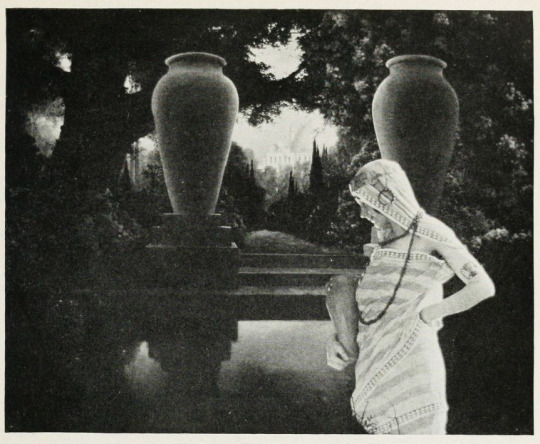


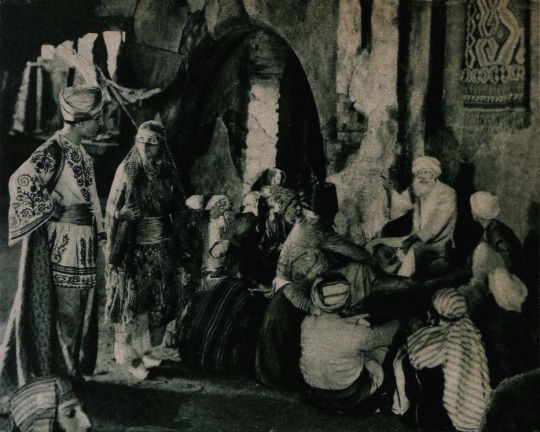
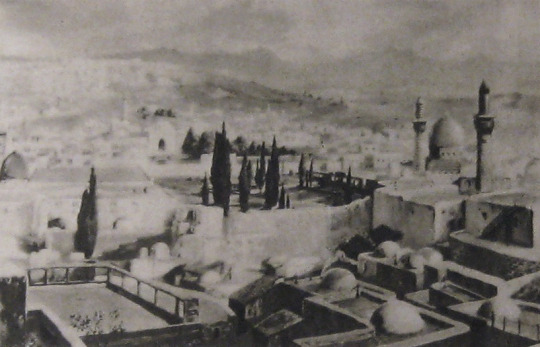

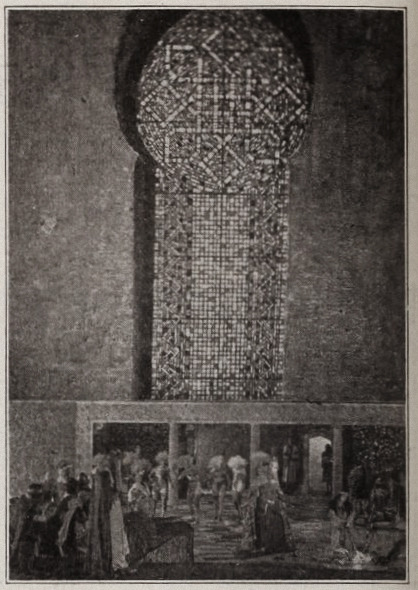
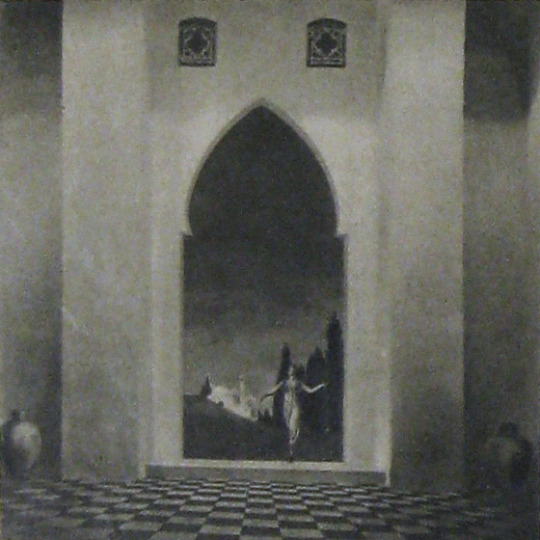



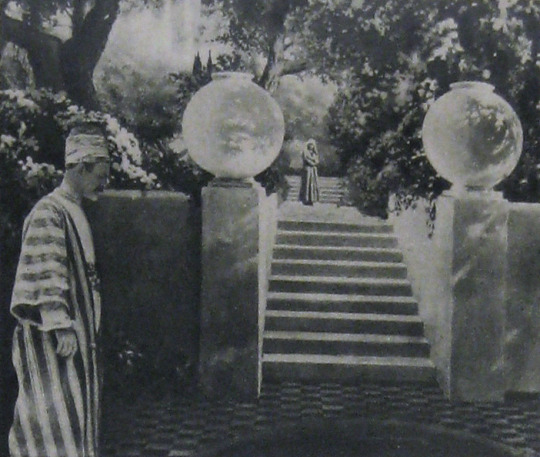
Alternate Titles: The Rubaiyat of Omar Khayyam, The Rubaiyat, Omar Khayyam, Omar
Direction: Ferdinand Pinney Earle; assisted by Walter Mayo
Scenario: Ferdinand P. Earle
Titles: Marion Ainslee, Ferdinand P. Earle (Omar), Louis Weadock (A Lover’s Oath)
Inspired by: The Rubaiyat of Omar Khayyam, as edited & translated by Edward FitzGerald
Production Manager: Winthrop Kelly
Camera: Georges Benoit
Still Photography: Edward S. Curtis
Special Photographic Effects: Ferdinand P. Earle, Gordon Bishop Pollock
Composer: Charles Wakefield Cadman
Editors: Arthur D. Ripley (The Rubaiyat of Omar Khayyam version), Ethel Davey & Ferdinand P. Earle (Omar / Omar Khayyam, the Director’s cut of 1922), Milton Sills (A Lover’s Oath)
Scenic Artists: Frank E. Berier, Xavier Muchado, Anthony Vecchio, Paul Detlefsen, Flora Smith, Jean Little Cyr, Robert Sterner, Ralph Willis
Character Designer: Louis Hels
Choreography: Ramon Novarro (credited as Ramon Samaniegos)
Technical Advisors: Prince Raphael Emmanuel, Reverend Allan Moore, Captain Dudley S. Corlette, & Captain Montlock or Mortlock
Studio: Ferdinand P. Earle Productions / The Rubaiyat, Inc. (Production) & Eastern Film Corporation (Distribution, Omar), Astor Distribution Corporation [States Rights market] (Distribution, A Lover’s Oath)
Performers: Frederick Warde, Edwin Stevens, Hedwiga Reicher, Mariska Aldrich, Paul Weigel, Robert Anderson, Arthur Carewe, Jesse Weldon, Snitz Edwards, Warren Rogers, Ramon Novarro (originally credited as Ramon Samaniegos), Big Jim Marcus, Kathleen Key, Charles A. Post, Phillippe de Lacy, Ferdinand Pinney Earle
Premiere(s): Omar cut: April 1922 The Ambassador Theatre, New York, NY (Preview Screening), 12 October 1923, Loew’s New York, New York, NY (Preview Screening), 2 February 1923, Hoyt’s Theatre, Sydney, Australia (Initial Release)
Status: Presumed lost, save for one 30 second fragment preserved by the Academy Film Archive, and a 2.5 minute fragment preserved by a private collector (Old Films & Stuff)
Length: Omar Khayyam: 8 reels , 76 minutes; A Lover’s Oath: 6 reels, 5,845 feet (though once listed with a runtime of 76 minutes, which doesn’t line up with the stated length of this cut)
Synopsis (synthesized from magazine summaries of the plot):
Omar Khayyam:
Set in 12th century Persia, the story begins with a preface in the youth of Omar Khayyam (Warde). Omar and his friends, Nizam (Weigel) and Hassan (Stevens), make a pact that whichever one of them becomes a success in life first will help out the others. In adulthood, Nizam has become a potentate and has given Omar a position so that he may continue his studies in mathematics and astronomy. Hassan, however, has grown into quite the villain. When he is expelled from the kingdom, he plots to kidnap Shireen (Key), the sheik’s daughter. Shireen is in love with Ali (Novarro). In the end it’s Hassan’s wife (Reicher) who slays the villain then kills herself.
A Lover’s Oath:
The daughter of a sheik, Shireen (Key), is in love with Ali (Novarro), the son of the ruler of a neighboring kingdom. Hassan covets Shireen and plots to kidnap her. Hassan is foiled by his wife. [The Sills’ edit places Ali and Shireen as protagonists, but there was little to no re-shooting done (absolutely none with Key or Novarro). So, most critics note how odd it is that all Ali does in the film is pitch woo, and does not save Shireen himself. This obviously wouldn’t have been an issue in the earlier cut, where Ali is a supporting character, often not even named in summaries and news items. Additional note: Post’s credit changes from “Vizier” to “Commander of the Faithful”]
Additional sequence(s) featured in the film (but I’m not sure where they fit in the continuity):
Celestial sequences featuring stars and planets moving through the cosmos
Angels spinning in a cyclone up to the heavens
A Potters’ shop sequence (relevant to a specific section of the poems)
Harem dance sequence choreographed by Novarro
Locations: palace gardens, street and marketplace scenes, ancient ruins


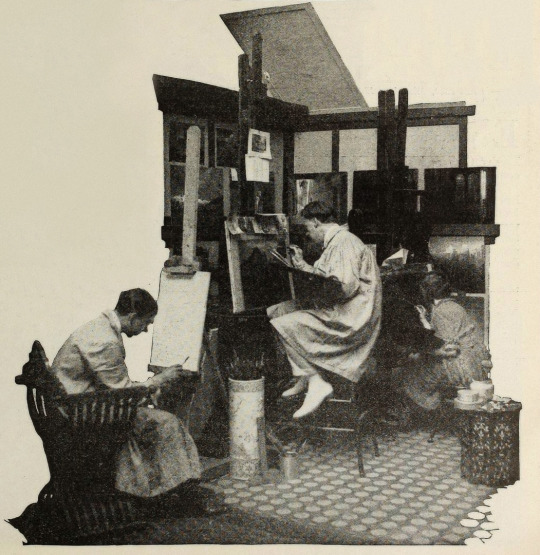


Points of Interest:
“The screen has been described as the last word in realism, but why confine it there? It can also be the last word in imaginative expression.”
Ferdinand P. Earle as quoted in Exhibitors Trade Review, 4 March 1922
The Rubaiyat of Omar Khayyam was a massive best seller. Ferdinand Pinney Earle was a classically trained artist who studied under William-Adolphe Bougueraeu and James McNeill Whistler in his youth. He also had years of experience creating art backgrounds, matte paintings, and art titles for films. Charles Wakefield Cadman was an accomplished composer of songs, operas, and operettas. Georges Benoit and Gordon Pollock were experienced photographic technicians. Edward S. Curtis was a widely renowned still photographer. Ramon Novarro was a name nobody knew yet—but they would soon enough.
When Earle chose The Rubaiyat as the source material for his directorial debut and collected such skilled collaborators, it seemed likely that the resulting film would be a landmark in the art of American cinema. Quite a few people who saw Earle’s Rubaiyat truly thought it would be:
William E. Wing writing for Camera, 9 September 1922, wrote:
“Mr. Earle…came from the world of brush and canvass, to spread his art upon the greater screen. He created a new Rubaiyat with such spiritual colors, that they swayed.”
…
“It has been my fortune to see some of the most wonderful sets that this Old Earth possesses, but I may truly say that none seized me more suddenly, or broke with greater, sudden inspiration upon the view and the brain, than some of Ferdinand Earle’s backgrounds, in his Rubaiyat.
“His vision and inspired art seem to promise something bigger and better for the future screen.”
As quoted in an ad in Film Year Book, 1923:
“Ferdinand Earle has set a new standard of production to live up to.”
Rex Ingram
“Fifty years ahead of the time.”
Marshall Neilan
The film was also listed among Fritz Lang’s Siegfried, Chaplin’s Gold Rush, Fairbanks’ Don Q, Lon Chaney’s Phantom of the Opera and The Unholy Three, and Erich Von Stroheim’s Merry Widow by the National Board of Review as an exceptional film of 1925.
So why don’t we all know about this film? (Spoiler: it’s not just because it’s lost!)
The short answer is that multiple dubious legal challenges arose that prevented Omar’s general release in the US. The long answer follows BELOW THE JUMP!
Earle began the project in earnest in 1919. Committing The Rubaiyat to film was an ambitious undertaking for a first-time director and Earle was striking out at a time when the American film industry was developing an inferiority complex about the level of artistry in their creative output. Earle was one of a number of artists in the film colony who were going independent of the emergent studio system for greater protections of their creative freedoms.
In their adaptation of The Rubaiyat of Omar Khayyam, Earle and Co. hoped to develop new and perfect existing techniques for incorporating live-action performers with paintings and expand the idea of what could be accomplished with photographic effects in filmmaking. The Rubaiyat was an inspired choice. It’s not a narrative, but a collection of poetry. This gave Earle the opportunity to intersperse fantastical, poetic sequences throughout a story set in the lifetime of Omar Khayyam, the credited writer of the poems. In addition to the fantastic, Earle’s team would recreate 12th century Persia for the screen.
Earle was convinced that if his methods were perfected, it wouldn’t matter when or where a scene was set, it would not just be possible but practical to put on film. For The Rubaiyat, the majority of shooting was done against black velvet and various matte photography and multiple exposure techniques were employed to bring a setting 800+ years in the past and 1000s of miles removed to life before a camera in a cottage in Los Angeles.
Note: If you’d like to learn a bit more about how these effects were executed at the time, see the first installment of How’d They Do That.
Unfortunately, the few surviving minutes don’t feature much of this special photography, but what does survive looks exquisite:

see all gifs here
Earle, knowing that traditional stills could not be taken while filming, brought in Edward S. Curtis. Curtis developed techniques in still photography to replicate the look of the photographic effects used for the film. So, even though the film hasn’t survived, we have some pretty great looking representations of some of the 1000s of missing feet of the film.
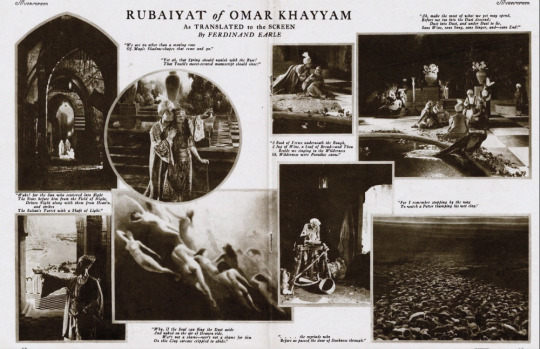
Nearly a year before Curtis joined the crew, Earle began collaboration with composer Charles Wakefield Cadman. In another bold creative move, Cadman and Earle worked closely before principal photography began so that the score could inform the construction and rhythm of the film and vice versa.
By the end of 1921 the film was complete. After roughly 9 months and the creation of over 500 paintings, The Rubaiyat was almost ready to meet its public. However, the investors in The Rubaiyat, Inc., the corporation formed by Earle to produce the film, objected to the ample reference to wine drinking (a comical objection if you’ve read the poems) and wanted the roles of the young lovers (played by as yet unknown Ramon Novarro and Kathleen Key) to be expanded. The dispute with Earle became so heated that the financiers absconded with the bulk of the film to New York. Earle filed suit against them in December to prevent them from screening their butchered and incomplete cut. Cadman supported Earle by withholding the use of his score for the film.
Later, Eastern Film Corp. brokered a settlement between the two parties, where Earle would get final cut of the film and Eastern would handle its release. Earle and Eastern agreed to change the title from The Rubaiyat of Omar Khayyam to simply Omar. Omar had its first official preview in New York City. It was tentatively announced that the film would have a wide release in the autumn.
However, before that autumn, director Norman Dawn launched a dubious patent-infringement suit against Earle and others. Dawn claimed that he owned the sole right to use multiple exposures, glass painting for single exposure, and other techniques that involved combining live action with paintings. All the cited techniques had been widespread in the film industry for a decade already and eventually and expectedly Dawn lost the suit. Despite Earle’s victory, the suit effectively put the kibosh on Omar’s release in the US.
Earle moved on to other projects that didn’t come to fruition, like a Theda Bara film and a frankly amazing sounding collaboration with Cadman to craft a silent-film opera of Faust. Omar did finally get a release, albeit only in Australia. Australian news outlets praised the film as highly as those few lucky attendees of the American preview screenings did. The narrative was described as not especially original, but that it was good enough in view of the film’s artistry and its imaginative “visual phenomena” and the precision of its technical achievement.
One reviewer for The Register, Adelaide, SA, wrote:
“It seems almost an impossibility to make a connected story out of the short verse of the Persian of old, yet the producer of this classic of the screen… has succeeded in providing an entertainment that would scarcely have been considered possible. From first to last the story grips with its very dramatic intensity.”
While Omar’s American release was still in limbo, “Ramon Samaniegos” made a huge impression in Rex Ingram’s Prisoner of Zenda (1922, extant) and Scaramouche (1923, extant) and took on a new name: Ramon Novarro. Excitement was mounting for Novarro’s next big role as the lead in the epic Ben-Hur (1925, extant) and the Omar project was re-vivified.

A new company, Astor Distribution Corp., was formed and purchased the distribution rights to Omar. Astor hired actor (note, not an editor) Milton Sills to re-cut the film to make Novarro and Key more prominent. The company also re-wrote the intertitles, reduced the films runtime by more than ten minutes, and renamed the film A Lover’s Oath. Earle had moved on by this point, vowing to never direct again. In fact, Earle was indirectly working with Novarro and Key again at the time, as an art director on Ben-Hur!
Despite Omar’s seemingly auspicious start in 1920, it was only released in the US on the states rights market as a cash-in on the success of one of its actors in a re-cut form five years later.
That said, A Lover’s Oath still received some good reviews from those who did manage to see it. Most of the negative criticism went to the story, intertitles, and Sills’ editing.
What kind of legacy could/should Omar have had? I’m obviously limited in my speculation by the fact that the film is lost, but there are a few key facts about the film’s production, release, and timing to consider.
The production budget was stated to be $174,735. That is equivalent to $3,246,994.83 in 2024 dollars. That is a lot of money, but since the production was years long and Omar was a period film set in a remote locale and features fantastical special effects sequences, it’s a modest budget. For contemporary perspective, Robin Hood (1922, extant) cost just under a million dollars to produce and Thief of Bagdad (1924, extant) cost over a million. For a film similarly steeped in spectacle to have nearly 1/10th of the budget is really very noteworthy. And, perhaps if the film had ever had a proper release in the US—in Earle’s intended form (that is to say, not the Sills cut)—Omar may have made as big of a splash as other epics.
It’s worth noting here however that there are a number of instances in contemporary trade and fan magazines where journalists off-handedly make this filmmaking experiment about undermining union workers. Essentially implying that that value of Earle’s method would be to continue production when unionized workers were striking. I’m sure that that would absolutely be a primary thought for studio heads, but it certainly wasn’t Earle’s motivation. Often when Earle talks about the method, he focuses on being able to film things that were previously impossible or impracticable to film. Driving down filming costs from Earle’s perspective was more about highlighting the artistry of his own specialty in lieu of other, more demanding and time-consuming approaches, like location shooting.
This divide between artists and studio decision makers is still at issue in the American film and television industry. Studio heads with billion dollar salaries constantly try to subvert unions of skilled professionals by pursuing (as yet) non-unionized labor. The technical developments of the past century have made Earle’s approach easier to implement. However, just because you don’t have to do quite as much math, or time an actor’s movements to a metronome, does not mean that filming a combination of painted/animated and live-action elements does not involve skilled labor.
VFX artists and animators are underappreciated and underpaid. In every new movie or TV show you watch there’s scads of VFX work done even in films/shows that have mundane, realistic settings. So, if you love a film or TV show, take the effort to appreciate the work of the humans who made it, even if their work was so good you didn’t notice it was done. And, if you’ve somehow read this far, and are so out of the loop about modern filmmaking, Disney’s “live-action” remakes are animated films, but they’ve just finagled ways to circumvent unions and low-key delegitimize the skilled labor of VFX artists and animators in the eyes of the viewing public. Don’t fall for it.
VFX workers in North America have a union under IATSE, but it’s still developing as a union and Marvel & Disney workers only voted to unionize in the autumn of 2023. The Animation Guild (TAG), also under the IATSE umbrella, has a longer history, but it’s been growing rapidly in the past year. A strike might be upcoming this year for TAG, so keep an eye out and remember to support striking workers and don’t cross picket lines, be they physical or digital!
Speaking of artistry over cost-cutting, I began this post with a mention that in the early 1920s, the American film industry was developing an inferiority complex in regard to its own artistry. This was in comparison to the European industries, Germany’s being the largest at the time. It’s frustrating to look back at this period and see acceptance of the opinion that American filmmakers weren’t bringing art to film. While yes, the emergent studio system was highly capitalistic and commercial, that does not mean the American industry was devoid of home-grown artists.
United Artists was formed in 1919 by Douglas Fairbanks, Charlie Chaplin, Mary Pickford, and D.W. Griffith precisely because studios were holding them back from investing in their art—within the same year that Earle began his Omar project. While salaries and unforgiving production schedules were also paramount concerns in the filmmakers going independent, a primary impetus was that production/distribution heads exhibited too much control over what the artists were trying to create.
Fairbanks was quickly expanding his repertoire in a more classical and fantastic direction. Cecil B. DeMille made his first in a long and very successful string of ancient epics. And the foreign-born children of the American film industry, Charlie Chaplin, Rex Ingram, and Nazimova, were poppin’ off! Chaplin was redefining comedic filmmaking. Ingram was redefining epics. Nazimova independently produced what is often regarded as America’s first art film, Salome (1923, extant), a film designed by Natacha Rambova, who was *gasp* American. Earle and his brother, William, had ambitious artistic visions of what could be done in the American industry and they also had to self-produce to get their work done.
Meanwhile, studio heads, instead of investing in the artists they already had contracts with, tried to poach talent from Europe with mixed success (in this period, see: Ernst Lubitsch, F.W. Murnau, Benjamin Christensen, Mauritz Stiller, Victor Sjöström, and so on). I’m in no way saying it was the wrong call to sign these artists, but all of these filmmakers, even if they found success in America, had stories of being hired to inject the style and artistry that they developed in Europe into American cinema, and then had their plans shot down or cut down to a shadow of their creative vision. Even Stiller, who tragically died before he had the opportunity to establish himself in the US, faced this on his first American film, The Temptress (1926, extant), on which he was replaced. Essentially, the studio heads’ actions were all hot air and spite for the filmmakers who’d gone independent.

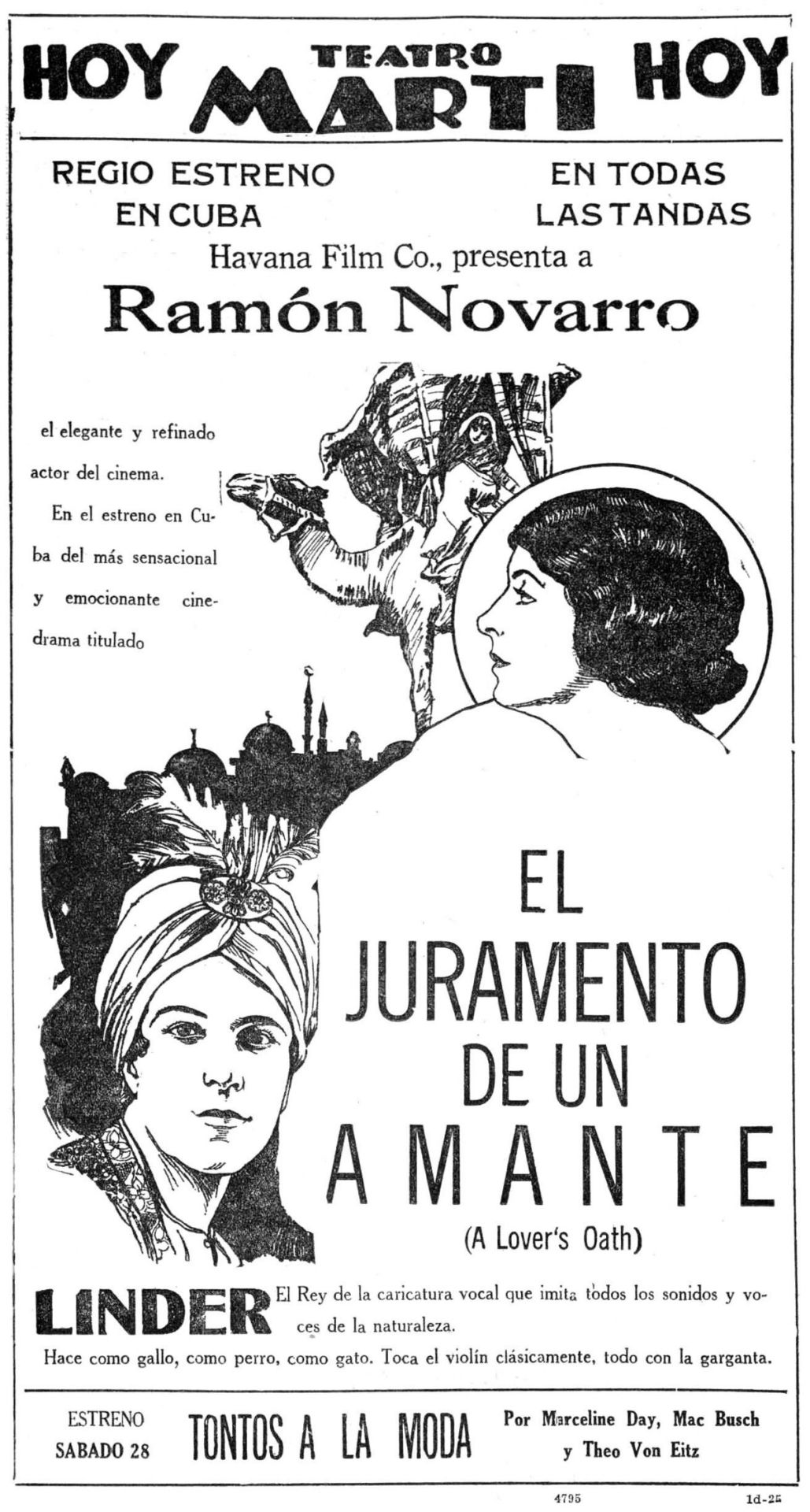
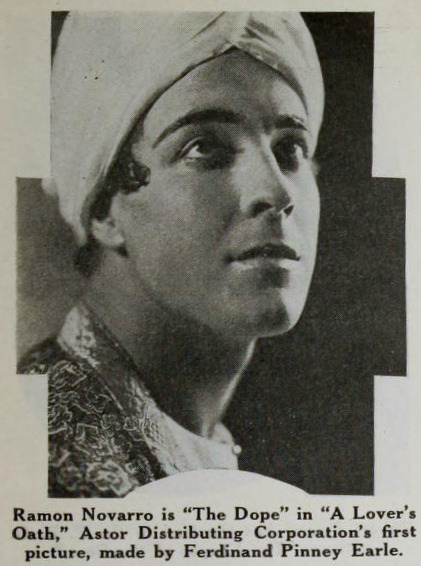
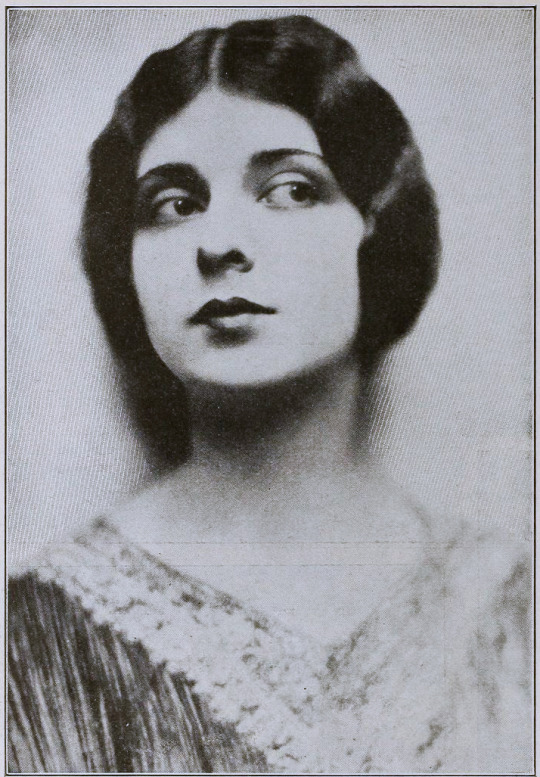
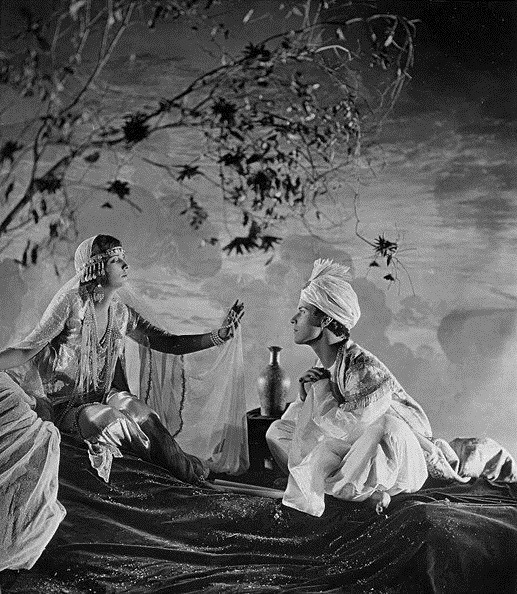
Finally I would like to highlight Ferdinand Earle’s statement to the industry, which he penned for from Camera in 14 January 1922, when his financial backers kidnapped his film to re-edit it on their terms:
MAGNA CHARTA
Until screen authors and producers obtain a charter specifying and guaranteeing their privileges and rights, the great slaughter of unprotected motion picture dramas will go merrily on.
Some of us who are half artists and half fighters and who are ready to expend ninety per cent of our energy in order to win the freedom to devote the remaining ten per cent to creative work on the screen, manage to bring to birth a piteous, half-starved art progeny.
The creative artist today labors without the stimulus of a public eager for his product, labors without the artistic momentum that fires the artist’s imagination and spurs his efforts as in any great art era.
Nowadays the taint of commercialism infects the seven arts, and the art pioneer meets with constant petty worries and handicaps.
Only once in a blue moon, in this matter-of-fact, dollar-wise age can the believer in better pictures hope to participate in a truely [sic] artistic treat.
In the seven years I have devoted to the screen, I have witnessed many splendid photodramas ruined by intruding upstarts and stubborn imbeciles. And I determined not to launch the production of my Opus No. 1 until I had adequately protected myself against all the usual evils of the way, especially as I was to make an entirely new type of picture.
In order that my film verison [sic] of the Rubaiyat of Omar Khayyam might be produced under ideal conditions and safeguarded from intolerable interferences and outside worries, I entered into a contract with the Rubaiyat, Inc., that made me not only president of the corporation and on the board of directors, but which set forth that I was to be author, production manager, director, cutter and film editor as well as art director, and that no charge could be made against the production without my written consent, and that my word was to be final on all matters of production. The late George Loane Tucker helped my attorney word the contract, which read like a splendid document.
Alas, I am now told that only by keeping title to a production until it is declared by yourself to be completed is it safe for a scenario writer, an actor or a director, who is supposedly making his own productions, to contract with a corporation; otherwise he is merely the servant of that corporation, subject at any moment to discharge, with the dubious redress of a suit for damages that can with difficulty be estimated and proven.
Can there be any hope of better pictures as long as contracts and copyrights are no protection against financial brigands and bullies?
We have scarcely emerged from barbarism, for contracts, solemnly drawn up between human beings, in which the purposes are set forth in the King’s plainest English, serve only as hurdles over which justice-mocking financiers and their nimble attorneys travel with impunity, riding rough shod over the author or artist who cannot support a legal army to defend his rights. The phrase is passed about that no contract is invioliable [sic]—and yet we think we have reached a state of civilization!
The suit begun by my attorneys in the federal courts to prevent the present hashed and incomplete version of my story from being released and exhibited, may be of interest to screen writers. For the whole struggle revolves not in the slightest degree around the sanctity of the contract, but centers around the federal copyright of my story which I never transferred in writing otherwise, and which is being brazenly ignored.
Imagine my production without pictorial titles: and imagine “The Rubaiyat” with a spoken title as follows, “That bird is getting to talk too much!”—beside some of the immortal quatrains of Fitzgerald!
One weapon, fortunately, remains for the militant art creator, when all is gone save his dignity and his sense of humor; and that is the rapier blade of ridicule, that can send lumbering to his retreat the most brutal and elephant-hided lord of finance.
How edifying—the tableau of the man of millions playing legal pranks upon men such as Charles Wakefield Cadman, Edward S. Curtis and myself and others who were associated in the bloody venture of picturizing the Rubaiyat! It has been gratifying to find the press of the whole country ready to champion the artist’s cause.
When the artist forges his plowshare into a sword, so to speak, he does not always put up a mean fight.
What publisher would dare to rewrite a sonnet of John Keats or alter one chord of a Chopin ballade?
Creative art of a high order will become possible on the screen only when the rights of established, independent screen producers, such as Rex Ingram and Maurice Tourneur, are no longer interferred with and their work no longer mutilated or changed or added to by vandal hands. And art dramas, conceived and executed by masters of screen craft, cannot be turned out like sausages made by factory hands. A flavor of individuality and distinction of style cannot be preserved in machine-made melodramas—a drama that is passed from hand to hand and concocted by patchworkers and tinkerers.
A thousand times no! For it will always be cousin to the sausage, and be like all other—sausages.
The scenes of a master’s drama may have a subtle pictorial continuity and a power of suggestion quite like a melody that is lost when just one note is changed. And the public is the only test of what is eternally true or false. What right have two or three people to deprive millions of art lovers of enjoying an artist’s creation as it emerged from his workshop?
“The Rubaiyat” was my first picture and produced in spite of continual and infernal interferences. It has taught me several sad lessons, which I have endeavored in the above paragraphs to pass on to some of my fellow sufferers. It is the hope that I am fighting, to a certain extent, their battle that has given me the courage to continue, and that has prompted me to write this article. May such hubbubs eventually teach or inforce a decent regard for the rights of authors and directors and tend to make the existence of screen artisans more secure and soothing to the nerves.
FERDINAND EARLE.
---
☕Appreciate my work? Buy me a coffee! ☕
Transcribed Sources & Annotations over on the WMM Blog!
See the Timeline for Ferdinand P. Earle's Rubaiyat Adaptation
#1920s#1923#1925#omar khayyam#ferdinand pinney earle#ramon novarro#independent film#american film#silent cinema#silent era#silent film#classic cinema#classic movies#classic film#film history#history#Charles Wakefield Cadman#cinematography#The Rubaiyat#cinema#film#lost film
41 notes
·
View notes
Text

Monday, April 15, 2024
I am posting on time today! Today was long. I am tired but fulfilled. Once again my language practice and reading had to be done in the car to and from ballet, but it's okay. It happens that way sometimes. Good night!
Tasks Completed:
Geometry - Reviewed factorial + learned about permutation and combination formulas + practice
Lit and Comp II - Copied Unit 24 vocabulary + read Act 2, Scenes 2-3 and Act 3, Scene 1 of Much Ado About Nothing by William Shakespeare + read modern translation of same scenes + found a line that used word play and cited it + worked on my literary analysis for Emma (due Friday)
Spanish 2 - Reviewed vocabulary + listened to a story in Spanish + practiced spelling clothing words
Bible I - Read 1 Samuel 17:20-58
World History - Read about the Tehran, Yalta, and Potsdam conferences + created a chart with information about the three conferences
Biology with Lab - Read about viruses + looked at viruses on a scale + watched videos "Cell vs Virus", "Catching a Cold", and "Viral Life Cycle" + wrote steps of what a virus does and how the body responds
Foundations - Read more on thriftiness + completed next quiz on Read Theory + answered second question set about Sojourner Truth’s “Ain’t I a Woman?” speech
Piano - Practiced for one hour
Khan Academy - Built into coursework
CLEP - Completed Module 12 reading "Europe: 1918-1945" 13.10.3
Streaming - Watched Greatest Events of World War II in Color episode 9
Duolingo - Studied for 30 minutes (Spanish, French, Chinese) + completed daily quests
Reading - Read pages 184-222 of Divine Rivals by Rebecca Ross
Chores - Cleaned my bathroom + cleaned windows in my bedroom and in the study + took the trash and recycling out
Activities of the Day:
Personal Bible Study (1 Peter 5)
Volunteered for two hours at the library
Ballet
Contemporary
Journal/Mindfulness
What I’m Grateful for Today:
I am grateful for allowing myself to take a break from tumblr because I felt more on top of things today.
Quote of the Day:
Be happy for this moment. This moment in your life.
-Omar Khayyam
🎧Eight Piano Pieces Op. 76 - Johannes Brahms
#study blog#study inspiration#study motivation#studyblr#studyblr community#study community#study-with-aura
19 notes
·
View notes
Text
🦘 Booklr Reads Australian - Authors on My Shelves 🐨
so, I’ve been trying to think of a way to recommend a lot of Australian authors really quickly for Booklr Reads Australian. what I came up with was just to give y’all a giant list of all the authors I have at home!
most of them are YA and/or fantasy authors, and I’ve marked my favourites with an asterisk (*) but if you have any questions, feel free to shoot me an ask 😊
1. Sarah Ayoub
2. Eugen Bacon
3. Shirley Barber *
4. AJ Betts
5. Danielle Binks *
6. Cally Black
7. Steph Bowe *
8. Alice Boyle
9. JC Burke
10. Meg Caddy *
11. Frances Chapman
12. Wai Chim *
13. Claire Christian
14. Lyndall Clipstone
15. Claire G Coleman
16. Katherine Collette
17. Harry Cook
18. Cath Crowley
19. Robyn Dennison
20. Cale Dietrich
21. Lauren Draper
22. CG Drews *
23. Michael Earp
24. Kate Emery
25. Sarah Epstein
26. Alison Evans *
27. Fleur Ferris
28. Carly Findlay
29. Helena Fox
30. Lisa Fuller
31. Emily Gale
32. Meg Gatland-Veness
33. Sophie Gonzales
34. Erin Gough *
35. Leanne Hall *
36. Pip Harry
37. Sonya Hartnett
38. Adam Hills
39. Simmone Howell
40. Megan Jacobson
41. Amie Kaufman
42. Melissa Keil
43. Nina Kenwood
44. Sharon Kernot
45. Kay Kerr *
46. Will Kostakis
47. Jay Kristoff
48. Ambelin Kwaymullina
49. Benjamin Law
50. Rebecca Lim
51. Gary Lonesborough *
52. Kathleen Loughnan
53. Miranda Luby
54. Tobias Madden
55. Melina Marchetta
56. Ellie Marney *
57. Freya Marske
58. Jodi McAlister *
59. Margot McGovern *
60. Nikki McWatters
61. Anna Morgan
62. Jaclyn Moriarty
63. Liane Moriarty
64. Garth Nix
65. Lynette Noni
66. Carly Nugent
67. Poppy Nwosu
68. Kate O’Donnell
69. Shivaun Plozza
70. Michael Pryor
71. Alice Pung
72. Emily Rodda *
73. Autumn Royal
74. Omar Sakr
75. Holden Sheppard
76. AG Slatter
77. Jo Spurrier
78. Krystal Sutherland *
79. Jared Thomas
80. Hayli Thompson
81. Gabrielle Tozer
82. Christos Tsiolkas
83. Alicia Tuckerman
84. Ellen van Neerven
85. Marlee Jane Ward
86. Vikki Wakefield
87. Lisa Walker
88. Jessica Watson *
89. Allayne L Webster
90. Anna Whateley *
91. Samantha Wheeler
92. Jen Wilde *
93. Rhiannon Wilde
94. Lili WIlkinson
95. Gabrielle Williams
96. Rhiannon Williams
97. Fiona Wood
98. Leanne Yong
99. Suzy Zail
100. Nevo Zisin
101. Markus Zusak
#booklr reads australian#booklr#bookblr#read australian#loveozya#trcc original#book recs#book recommendations
21 notes
·
View notes
Note
How much 💰 do you think Omar's fragrance will cost?
I have never bought perfume in my life so I know very little but I am also curious!
@levok estimated 50-70€ ($55-76), and @kruemel8 estimated 50-60€ ($55-65) for me (thank you!), and your research (ty "anon" lolol) turned up other celeb perfumes around $65-70. So with all that in mind I'll shoot on the higher end and guess 66€ / $72 / 762 SEK 💜
8 notes
·
View notes
Text
OC Personality Match Quiz
Eeeeeyyy I've been tagged by @pinkyjulien @ouroboros-hideout and @therealnightcity in this a while ago and finally had the headspace to sit down and do it :DDD
Rules are to take this quiz for a blorbo of choice, and ofc I picked Vince!

Here's the top 10 results:
Alan Shore (Boston Legal): 78%
Tyrion Lannister (Game of Thrones): 76%
Alicia Florrick (The Good Wife): 76%
Kim Wexler (Better Call Saul): 76%
Omar Little (The Wire): 75%
Brian O'Conner (Fast & Furious): 75%
Danny Ocean (Ocean's 11): 75%
Mike Ross (Suits): 75%
Neal Caffrey (White Collar): 75%
Rebecca Welton (Ted Lasso): 75%
Sadly... I know only three of these, and only one well xD Tyrion Lannister, Kim Wexler (beloved), and Danny Ocean. I read up on Alan Shore, and apparently, like Kim, he is also a shifty lawyer who has strong principles but is not shy to play against the rules and fights for underdogs xDD Maybe that's Vince's true calling? Lawyer AU? Ngl I could definitely see it XDD AND he looks good in fancy suits... I might be onto something here fr now... Already established that he'd definitely be a rules lawyer playing DND at least!
If you know one of these characters better than me I'd love to know more about them and if they could fit Vince personality-wise! :D
5 notes
·
View notes
Text
top 100 characters
statistical "which character" is similar to yours personality quiz
**picking five characters i know to add to the list while i take a couple!!*
Nomi Marks (Sense8): 83%
Marianne (Portrait of a Lady): 83%
Inej Ghafa (Shadow and Bone): 83%
Salvatore Romano (Mad Men): 82%
F o x M u l d e r (T h e X - F i l e s): 82%
Torvi (Vikings): 82%
Baby (Baby Driver): 82%
Ally Maine (A Star Is Born): 82%
Marie Kreutz (The Bourne Identity): 81%
Riley Blue (Sense8): 81%
Elisa Esposito (The Shape of Water): 81%
Buck Vu (The OA): 81%
Alice Cullen (Twilight): 80%
Abby Sciuto (NCIS): 80%
Ben Hargreeves (TUA): 80%
Andy Dufresne (The Shawshank Redemption): 80%
Floki (Vikings): 80%
Rogue (X-Men): 80%
Amanita Caplan (Sense8): 80%
Juliana Crain (The Man in the HC): 80%
Ola Nyman (Sex Ed): 80%
Willow Rosenberg (Buffy): 79%
Neo (The Matrix): 79%
Ariadne (Inception): 79%
Guinan (Star Trek: TNG): 79%
W i l l G r a h a m (H a n n i b a l): 79%
Bonnie Bennett (TVD): 79%
Monica Dutton (Yellowstone): 79%
Sam Button (The Perks): 79%
Frenchie (The Boys): 79%
Robin Buckley (ST): 79%
Marianne Sheridan (Normal People): 79%
W a n d a M a x i m o f f (WandaVision): 79%
Violet Parr (The Incredibles): 79%
Luna Lovegood (HP): 78%
Nymphadora Tonks (HP): 78%
Trinity (The Matrix): 78%
Jasper Hale (Twilight): 78%
Toni Topaz (Riverdale): 78%
Kalinda Sharma (The Good Wife): 78%
Han Lue (Fast & Furious): 78%
Amélie Poulain (Amélie): 78%
Maeve Wiley (Sex Education): 78%
Cassie Thomas (Promising Young Woman): 78%
River Tam (Firefly): 77%
Omar Little (The Wire): 77%
Morpheus (The Matrix): 77%
William H. 'Shakespeare' Hill (This Is Us): 77%
Jonah Byrde (Ozark): 77%
Chris Washington (Get Out): 77%
Lane Kim (Gilmore Girls): 77%
Céline (Before Sunrise): 77%
Ada Shelby (Peaky Blinders): 77%
Jonathan Byers (ST): 77%
Benjamin Button (TCCBB): 77%
Heloise (Portrait of a Lady): 77%
Lily Iglehart (Sex Ed): 77%
Naomi Nagata (The Expanse): 77%
Hester Prynne (The Scarlet Letter): 77%
Remus Lupin (HP): 76%
Maeve Millay (Westworld): 76%
Daniel Jackson (Stargate SG-1): 76%
Rosalind Walker (CAOS): 76%
Storm (X-Men): 76%
Hernando Fuentes (Sense8): 76%
Dr. Sean Maguire (Good Will Hunting): 76%
Mozzie (White Collar): 76%
Kinsey Locke (Locke & Key): 76%
J o h n W i c k (John Wick): 76%
Ekko (Arcane): 76%
Albus Dumbledore (HP): 75%
Inara Serra (Firefly): 75%
D'Angelo Barksdale (The Wire): 75%
Janis Ian (Mean Girls): 75%
Damian Leigh (Mean Girls): 75%
Dom Cobb (Inception): 75%
Michael Scofield (Prison Break): 75%
Jughead Jones (Riverdale): 75%
Darlene (Mr. Robot): 75%
Wyldstyle (The Lego Movie): 75%
Nairobi (Money Heist): 75%
Penelope (The Odyssey): 75%
Aunt Polly (Peaky Blinders): 75%
Penelope Garcia (Criminal Minds): 75%
Joyce Byers (ST): 75%
Will Byers (ST): 75%
Angela Montenegro (Bones): 75%
Maleficent (Maleficent): 75%
Kang Sae-byeok (Squid Game): 75%
Jules Vaughn (Euphoria): 75%
Viktor (Arcane): 75%
Suzuha Amane (Steins;Gate): 75%
Natalie (Yellowjackets): 75%
Jyn Erso (Rogue One): 75%
S i r i u s B l a c k (HP): 74%
Elizabeth Bennet (Pride & Prejudice): 74%
Black Widow (MCU): 74%
Paul Smecker (Boondock Saints): 74%
Ciri (The Witcher): 74%
Kurt Hummel (Glee): 73%
8 notes
·
View notes
Text
CR posted a video today that Bells Hells leveled up! Quick summary of the results:
Ashton: 94 + (7 + 4) for 105 HP
Orym: 71 + (10 + 2) for 83 HP, plus a well-deserved brag that his passive perception is now 31
Imogen: 51 + (5 + 2) for 58 HP (guest star Omar was very excited for this roll)
Fearne: taking a level in Druid, 56 + (5 + 2) for 63 HP
FCG: taking a level in Omar aka Corgi-leric, 76 + (5 + 4) for 85 HP
Laudna: taking level in Sorcerer, 71 + (5 + 4) for 80 HP
Chetney: taking a level in Blood Hunter, 68 + (7 + 2) for 77 HP
#Critical Role#campaign 3#cr spoilers#critical role spoilers#campaign 3 spoilers#Bree's stuff#about me#about Bree
13 notes
·
View notes
Text
My corresponding Spotify Wrapped songs to my favorite hockey players from my top 100 year 3:
• 2 (Brendan Smith)- august by Taylor Swift
• 4 (Braden Schneider)- El Tango De Roxanne by Original Broadway Cast of Moulin Rouge! The Musical
• 6 (Erik Johnson)- my tears ricochet by Taylor Swift
• 7 (Jordan Eberle)- All I Wanted by Paramore
• 8 (Noah Dobson, Jacob Trouba)- ceilings by Lizzy McAlpine
• 10 (Vinni Littieri, Artemi Panarin)- The Archer by Taylor Swift
• 11 (Trevor Zegras)- You Don’t Go To Parties by 5 Seconds of Summer
• 13 (Mat Barzal, Kevin Hayes, Nico Hischier, Alexis Lafreniere)- Stick Season by Noah Kahan
• 15 (Cal Clutterbuck)- TEARS! by 5 Seconds of Summer
• 16 (Mitch Marner)- Evergreen (You Didn’t Deserve Me At All) by Omar Apollo
• 17 (Matt Martin, Tyson Jost)- Gilded Lily by Cults
• 19 (Matthew Tkachuk)- High by 5 Seconds of Summer
• 20 (Chris Kreider)- Graceland Too by Phoebe Bridgers
• 21 (Kyle Okposo)- The View Between Villages by Noah Kahan
• 22 (Cole Caufield, Kevin Fiala)- epiphany by Taylor Swift
• 24 (Scott Mayfield)- Waiting Room by Phoebe Bridgers
• 26 (Jimmy Vessey)- this is me trying by Taylor Swift
• 27 (Ryan McDonagh, Anders Lee)- Bleach by 5 Seconds of Summer
• 29 (Nathan MacKinnon, Leon Draisaitl, Marc-Andre Fluery, Brock Nelson)- Motion Sickness by Phoebe Bridgers
• 30 (Ilya Sorokin)- Out Of The Woods by Taylor Swift
• 31 (Igor Shesterkin)- Life On Mars? by David Bowie
• 36 (Mats Zuccarello)- I Know The End by Phoebe Bridgers
• 37 (Andrei Svechnikov)- Francesca by Hozier
• 40 (Semyon Varlamov)- Dial Drunk by Noah Kahan
• 43 (Quinn Hughes)- Twin Size Mattress by The Front Bottoms
• 53 (Casey Cizikas)- Starting Line by Luke Hemings
• 58 (Kris Letang)- Wildest Dreams (Taylor’s Version) by Taylor Swift
• 63 (Brad Marchand)- No Shame by 5 Seconds of Summer
• 72 (Anthony Beauvillier)- Strange by Celeste
• 75 (Ryan Reaves)- Jet Black Heart by 5 Seconds of Summer
• 76 (Brady Skjei)- Heroes by David Bowie
• 79 (K’Andre Miller)- Blender by 5 Seconds of Summer
• 87 (Sidney Crosby)- English Love Affair by 5 Seconds of Summer
• 88 (David Pastrnak)- I Wish I Never Met You by Babygirl
• 89 (Pavel Buchnevich)- If It Makes You Happy by Michael Cera Palin
• 91 (Tyler Seguin, Vladimir Taresenko, John Tavares)- Everything I Didn’t Say by 5 Seconds of Summer
• 93 (Mika Zibanejad)- Stay Together For The Kids by Blink-182
See you next year 🫶🫶
4 notes
·
View notes
Quote
“Hacer lo útil, decir lo justo y contemplar lo bello es bastante para una vida de hombre”
T.S. Eliot
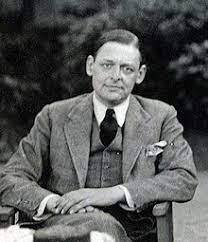
Thomas Stern Eliot, fue un poeta, dramaturgo y critico literario británico estadounidense nacido en San Luis Misuri en septiembre de 1888.
Representó una de las cumbres de la poesía en lengua inglesa del siglo XX.
Su padre era un importante hombre de negocios, y su madre una aficionada a la literatura.
Debido a limitaciones físicas desde su niñez, y debido a este aislamiento desarrolló su pasión por la literatura.
Una vez aprendió a leer, se dejó envolver por las historias del salvaje oeste y por las peripecias de Tom Sawyer de Mark Twain.
De 1898 a 1905, Thomas estudió en la Smith Academy de Saint Louis destacando en todas las materias desde latín a física, comenzando a escribir poesía a los 14 años, de donde las Rubaiyat de Omar Jayam, le servirían de inspiración.
En 1906 ingresa a la Universidad de Harvard done estudió griego, literatura inglesa, alemán, historia medieval e historia del arte, doctorándose en 1911 en filosofía, con una tesis sobre F.H. Bradley filósofo británico exponente del idealismo absoluto, derivado de la obra del filosofo Friedrich Hegel.
En Harvard, es nombrado profesor ayudante de filosofía y conoce al británico premio Nobel Bertrand Russell, quien juzga a T.S. Eliot como su mejor alumno y en donde es becado para estudiar en Alemania, estudios que no pudo realizar debido a la guerra, y ante el inicio de esta, huye del país trasladándose a Inglaterra.
Es Ezra Pound, el poeta y músico estadounidense quién lo introduce en el mundo literario inglés.
En 1917, aparece su primer gran poema: “La canción de amor de J. Alfred Prufrock” una de las obras mas citadas del autor, quien pone en manifiesto su vocación experimental.
Después de publicar un conjunto de obras poéticas y ensayos críticos, y de su poema “La tierra baldía” quién lo haría célebre a nivel mundial. Funda en 1922 la revista Criterion.
En 1943 aparecerá el libro que tanto él mismo como gran parte de la critica considera su obra maestra “Four Quartets” Esta obra, está compuesta de cuatro poemas relacionados entre si, abarca 30 años de filosofía y misticismo, en donde la imaginería cristiana y el simbolismo abundarían en sus poemas. A partir de entonces su poesía no volverá a alcanzar tales cotas de calidad, sin embargo, el máximo reconocimiento le llegará en 1948 con el otorgamiento del Premio Nobel de Literatura y la Orden del Mérito del Reino Unido, ambos en el mismo año.
Eliot fallece en Londres a la edad de 76 años de un enfisema pulmonar,
Fuente Wikipedia.
#frases#Frases Inspiradoras#poetas#poetas contemporáneos#t.s. eliot#premio nobel#literatura#literature#frases motivadoras#citas de la vida#citas celebres
20 notes
·
View notes
Text
By Omar Afra- What Is The Importance of Brand Reputation?
It sounds apparent that a very good popularity matters, however, its function can`t be harassed enough. Simply positioned, a commercial enterprise is best as suitable as its popularity. This applies to international manufacturers in addition to neighbourhood businesses, and the entirety in between.

Consumers are increasingly knowledgeable approximately the corporations they do commercial enterprise with. In fact, 85% of purchasers study manufacturers and merchandise online earlier than creating a shopping decision. And 86% could pay greater for offerings from a business enterprise in the event that they had higher popularity than a less expensive competitor.
What's greater, a business enterprise`s virtual presence isn't like a commercial enterprise card or brochure. It’s a dynamic, evolving, multi-channel entity. Some of these channels you manipulate, like your internet site and weblog.
User-generated content material performs a heavy function for your popularity improvement due to the fact human beings are much more likely to consider it in comparison to business enterprise-subsidized marketing.
Interestingly, 76% of corporations trust they may be higher than common with regards to popularity. That sounds a very positive bell and illustrates corporations probable nevertheless have a few paintings to do. If you aren't inside the above-common category, then it's time to elevate the bar on what “common” popularity can do!
What Shapes a Brand's Reputation?
An instance of consumer critiques on a computing device computer.
We`ve protected not unusual place questions like “What is popularity?” and “Why is popularity important?”, manufacturers additionally want to understand the elements that assist to form their online presence.
Reputations pass past wonderful critiques or terrible critiques, even though those do play a function.
You can construct a robust logo photograph primarily based totally on the subsequent details:
Visual cues. Company name, logo, and all the imagery associated with your visible identification beef up a regular logo name.
You can check out how marketing and designing are different from each other - By Omar Afra here.
Mission, vision, fee proposition, or philosophy. The guiding mild of a business enterprise`s inner culture, those factors have a ripple impact with regard to company popularity.
The behavior of contributors with inside the organization.
What human beings are pronouncing or writing is key. Articles, phrase of mouth, information, social media, and online critiques.
The achievement and positioning of the commercial enterprise.
You have greater control over your business enterprise`s popularity than you would possibly realize.
Business Reputations are Earned – and Managed
A cool animated film drawing of someone leaving a 4-famous person consumer evaluation subsequent to a giant molecular phone
When you first begin your business enterprise, you don’t have lots of popularity to talk of. So wherein do reputations come from?
I, Omar Afra see the aspects of this coin:
The first is the popularity your commercial enterprise is actively pursuing. For example, if you`re looking to construct wonderful popularity, you then definitely may spend money on a logo control strategy, media relations, and a popularity control solution.
The 2nd facet of the coin is different human beings: your clients, prospects, and the overall public. Every time a person interacts together along with your business enterprise, you`re constructing your commercial enterprise popularity.
13 notes
·
View notes
Text
'Untitled' Chapter 5: Mitty the Sin Killer
74 & 75


76

77 & 78

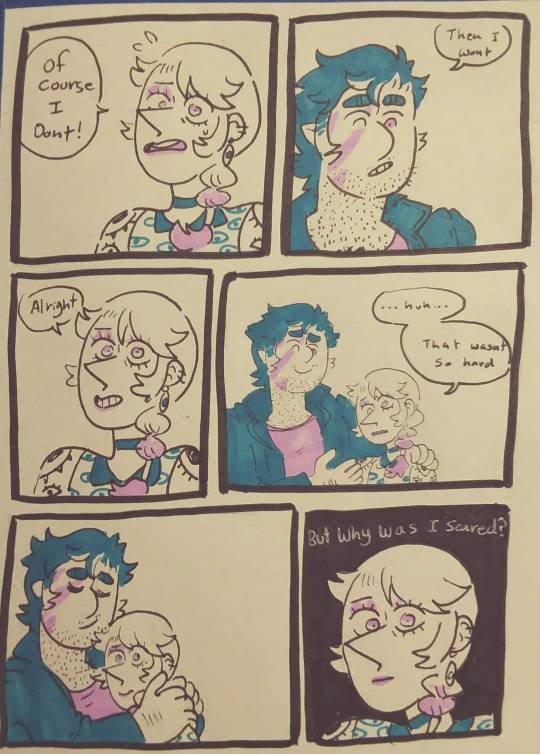
79 & 80
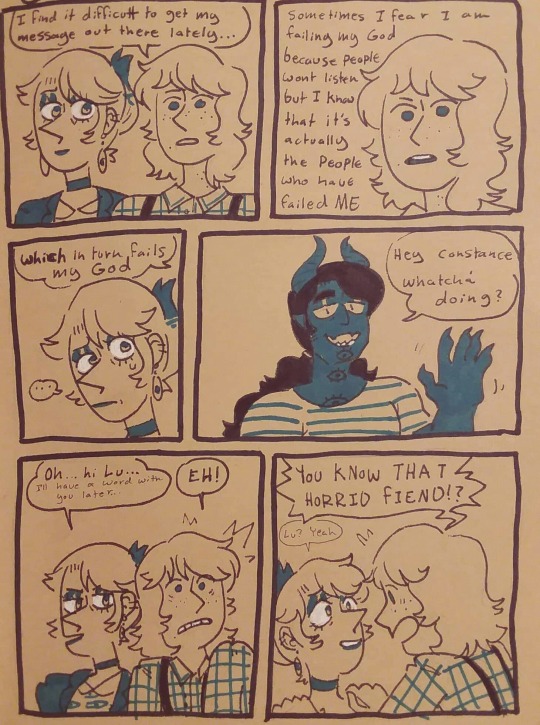

81

82
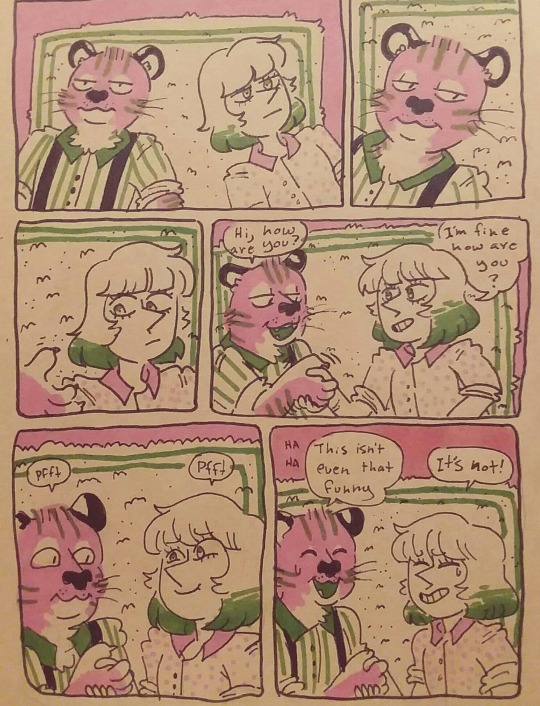
Never mentioned it before but Constance's brother is named Omar
Originally I was going to do a page where Constance confronted Lulu about outing her to Robin but that never happened in the draft, whenever I get around to finishing the actual comic, which I got a bit done already is going to have it there instead.
I feel like the draft is disjointed sometimes and it is
I wish I knew more about publishing because that's what's holding me back and I don't even know where to start
I don't want to go through a company
Mostly because I just don't want to change it, I want to expand on it and improve it but not with someone else's input
Right now, I can't talk about what 'Untitled'is about but if you keep up with me we'll get there
◀️ Prev • Next ▶️
#untitled#I think these are the only pages that#really go into Constance being transgender#because afterwards nobody brigs it up#and everyone accepts her as she is#really thats how it should be#original character#original comic#my ocs#oc#original characters#comics#devil#vent art#werewolf#i need to come up with a tag for Mitty#idk#something religious#but what#anthro tiger
5 notes
·
View notes
Note
Please, I'm very curious about No One's Safe At Home and What Happened To Vault 76? 😃
Ah yes, I'm glad those two have caught your attention.
What Happened To Vault 76? is a Fallout 76 fic that is the fifth installment of the A Radioactive Calamity of Love, Bombs & Gore series, but technically the prequel which predates the other five fics.
Essentially, a Resident of Vault 76, Vega, sleeps in and misses out on everyone entering the world after the bombs dropped 25 years beforehand. After Vega leaves the vault, Vega learns that she was left behind on purpose, because for a lack of better words, she's the worst. Vega takes offense to this "treachery" and decides to go out and hunt down her fellow residents as well as Vault 76's Overseer (who she develops a rather cringe unhealthy obsession over). The Scorched and the raiders hardly phase Vega, nor do the super mutants. However, she does bump into two odd strangers; Matthias "Mason" Talos and his brother, Arcane Urias. They're odd because the Scorch doesn't seem to affect them like it does everyone else, and there's also the fact of their inhuman strength and off human appearance. But Vega takes the opportunity to gaslight, gatekeep and manipulate these guys into helping her kill the rest of her former compatriots. On the trio's journey, Mason gets more skeptical of Vega's word, but Urias takes an awful lot of interest in the Scorched and its origin. That's all I got for now.
However, No One's Safe At Home is a Welcome To The Game franchise fic apart of The Silver Chronicles. It's essentially the origin story for an OC of mine, a key character in La Última En Pie and Old Dusk (two Silva Omar centered fics), named Gavin Turquoise.
In the Silva centered fics, Gavin is a lawyer with connections to the criminal underworld, but not because he works for them, merely because he monitors who he wants to put away for good. Anyway, in No One's Safe At Home, it reveals that before Gavin was a lawyer, he was a former benefactor of shady organizations turned vigilante who got sick of the injustice that the worst people alive kept getting away with, especially after his little nephew (who Gavin had personally became a male role model to) was taken by said people, and started hunting them down. He found two connections between all of them; The Dark Web, and an organization called "the Ministry". So Gavin made it his life long mission to wipe these people off the face of the Earth. Not only to avenge his nephew, but also so Gavin can rig the "Game" in his favor, take the benefits of the power and rebuild this empire into something more honorable (as it has deviated so, so far from what it used to be).
In essence, this is like a revenge story where one of the benefactor's of the Dark Web is personally punched in the gut by the organization he helped rise up, taking away and likely killing his nephew (or worse) and now Gavin wants to get rid of the source of the stains that corrupt the vision he had for this empire and rebuild from the bloody foundations he'll leave behind. The story is also about Gavin choosing to get his revenge but not perpetuating the cycle by rebuilding an organization that's very nature is to cause misery to others, no matter how honorable he tries to make it.
In other words, Gavin kills the most disgusting and worst people to exist and it is so satisfying.
I've put together a bit of the beginning of the fic down below:
Vigorously tapping on the keyboard, he shifted his attention to the time and date at the bottom right corner.
3:17 AM... 23rd of October... only seven more days left.
While the contents of the Red Room held no value to him, tracking the livestream would allow the location to be given away. Give him an ample opportunity take another sick fuck off the list.
He just had to go deeper.
Moving to browse on another degenerate site, Gavin paused. He glanced to the bottom right corner once more, attention caught by the white arrow next to the wifi indicator.
A GPS tracker, he recognized, How long had THAT been there?
Without wasting any more time, Gavin pushed himself out of the chair and reached to turn the computer's power off. But he stopped, thinking it over.
On second thought... I do have an opportunity here.
Gavin moved away from the computer, and walked over to the light switch, flicking it off. Darkness embraced the room, with the only light bathing inside this void coming from his computer screen.
Gavin brought out a hiking pack, placing it on the chair, and moved to the other side of the room, hand reaching for his most effective tool, eyes on the window.
He waited in bated breath, back against the wall as he waited for the window to inevitably open. He listened out of the cues he had honed himself to recognize for the past twenty-three days; the soft knocks, the footsteps on gravel, and even tugging up the windows.
Gavin's adversary did not know his identity yet; if he had, Gavin was sure he'd stop being lured out to the same neighborhood for the past twenty-three days.
From what Gavin overheard between Miss Lydia and Mr. Adam's call, Gavin's tracker didn't have a known name. Simply referred to as "the Kidnapper". Though creativity was lacking, the crimes were quite horrific. A masked man from Russia with ties to a sex trafficking ring, kidnapping women to subject them to horrors hidden from the law's eye.
He hears low grumbling. Gavin watches as the silhouette of the monster himself shadowed the moonlight, the dreadful figure of a beast shaped as a human. Gloved hands as black as the empty caverns that should house his soul, hands that have ripped innocent women in the wake of night away from their lives, gripping the window and dragging it up, up, up.
Gavin wasn't idealistic; he knew if he killed this man, it wouldn't hinder the trafficking ring in the slightest. But Gavin was sure of two things; one less woman will be awake and afraid at night, and one less monster would be walking amongst society. And Gavin was going to take so much satisfaction from this.
#series: a radioactive calamity of love bombs & gore#fallout#fallout 76#wip: what happened to vault 76?#the resident#oc: vega#oc: arcane urias#oc: matthias “mason” talos#the scorched#the overseer#the silver chronicles#welcome to the game#wip: no one's safe at home#oc: gavin turquoise#lydia the nympho#wttg adam#the kidnapper
1 note
·
View note
Text
Burnie 1 Ch SF: Alex Bolt def. Yasutaka Uchiyama [6] 6-7(7), 7-6(4), 6-3 Match Stats

📸 ATP official website
This match turned out to be return-heavy since it boiled down to the tie-breakers. The net game contributed a lot in their pressing moments there, where Y. Uchiyama's volley converted his latest set point in the first set, and so did A. Bolt's mini-break in the second set before his forehands created the damage in the second set. This way, A. Bolt appeared more aggressive and intuitive, outhitting Y. Uchiyama's baseline game as a consequence, which contributed to his 7 break points, converting it twice between the first and the third sets despite Y. Uchiyama's 33% break point conversion rate.
Service game-wise, Y. Uchiyama surprisingly had the edge but could not sustain the moment toward the end of the match. Despite A. Bolt firing 4 more aces than Y. Uchiyama (10 to 6), the latter slightly stood out in his first serves by 1% with 76% winning percentage. Furthermore, A. Bolt's second serves became problematic since he could only win 56% points from there, 9% lesser due to his 4 double faults, twice more than Y. Uchiyama along the way.
An all-Australian final will be present as Omar Jasika defeated qualifier Shintaro Imai 7-5, 6-3 later that day in the semifinals. Considering both players' resurgence, this could be a classic match with every element being tested: being more offensive could be one of the keys while constructing their points. Should be an exciting encounter because whoever nailed this match will get a possible boost in their comeback campaigns.
#atp world tour#atp tour#atp challenger#atp challenger tour#tennis updates#match stats#burnie 1 challenger#hci burnie international 1#alex bolt#yasutaka uchiyama#WatchChallengersFolks#ChallengerMatters
0 notes
Text
21 Eylül 2023 NBA G League Ignite Al Ahly Maçı
*Singapur'daki Singapur Kapalı Stadyum'da saat 14:00'te başlayacak olan 2023 FIBA Kıtalar Arası Kupa (Singapur) A Grubu maçı.
*FIBA YouTube kanalından naklen yayınlanacak olan maç.
*İlk çeyreğin sonunda 21-20 ile Ignite üstün konumda. Maça çok etkili başlayan bir Al Ahly vardı esasında. 20-11'den sonra ABD ekibi Ignite 10 sayılık bir seriyle çeyreği noktaladı ve son nefeste öne geçti.
*İlk yarıyı Al Ahly 45-43 önde kapattı. Mısır ekibi üretken oyunu ile hakimiyetini çabuk geri aldı. Farkı zaman zaman 9'a kadar çıkarmışlardı ama 41-33'ten sonra Ignite 10-4'lük bir sekans oynayarak mücadeleye tutundu.
*Üçüncü periyodun bitimiyle Al Ahly skoru 62-59 yaptı. Maçın en çekişmeli bölümünü izledik. İki tarafa da gitti geldi üstünlük. Lakin Ignite 53-52 öndeyken Al Ahly 10-6'lık refleksle kontrolü yeniden eline geçirdi.
*Al Ahly'nin 82-76 kazandığı mücadele. Mısır ekibi organizasyona galibiyetle başladı böylece. Bu periyotta zaman zaman 10 sayılık farklar yakaladılar. Kontrollü şekilde sonuca gittiler. NBA G League Ignite'ta Tyler Smith 18, John Jenkins 16 sayı kaydetti. Al Ahly'de ise Ehab Amin 15 sayı ile oynadı. Omar Oraby 14 sayı - 11 ribaund ile ve Mostafa Kejo 10 sayı - 13 ribaund ile ikili çifte katkısı sundular.
#spor arşivi#maç arşivi#2023 fiba kıtalar arası kupa singapur#nba g league ignite#al ahly#basketbol#basketball#spor#sport
0 notes